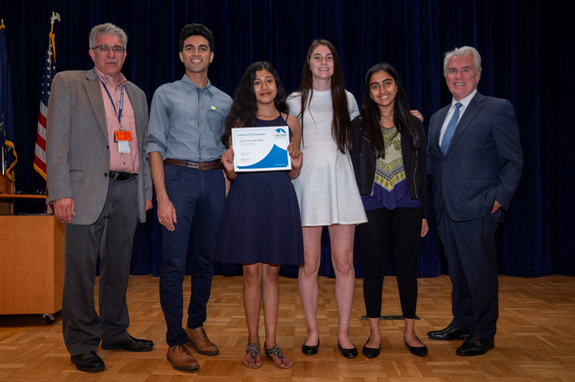Sachem North Students present long-term ecological data at Brookhaven National Lab’s Open Space Stewardship Conference
Three Sachem North students, Grace McGowan, Annadamaye Ghosh and Nistha Boghra, presented a poster of the long-term data set from the Sunken Meadow Creek restoration project.
Estuaries provide essential ecosystem functions and values to natural systems, as well as to human beneficiaries. Despite their importance, coastal estuaries are extremely vulnerable to degradation from human impacts.
Sunken Meadow Creek, located within Sunken Meadow State Park in King’s Park, NY, was a free flowing tidal tributary to the Nissequogue River and LI Sound, before it was impounded by a dike in the 1950’s. Multiple state and federal agencies partnered to restore tidal flow and allow for natural ecosystem restoration to 132-acres of former estuarine habitat that had transitioned to a freshwater marsh environment. The Resiliency & Restoration Project at Sunken Meadow Park has four main goals:
- Manage stormwater to reduce flooding and improve water quality in Sunken Meadow Creek
- Strengthen and promote the resilience of the Sunken Meadow marshes
- Explore improvements to Sunken Meadow Creek’s riverine habitat
- Improve public knowledge and understanding of the ecological communities in Sunken Meadow
As a part of last goal to include environmental education, Sachem North has aided in a long-term, habitat-monitoring program to document changes in Sunken Meadow Creek, before and after tidal flow restoration for over 10 years. Both baseline (pre-restoration) data, and ongoing, post-restoration monitoring data have been collected and were presented at the conference.
The restoration has undoubtedly improved fish access to spawning areas and provided nursery habitats for many economically important species, such as flounder, American eel, alewife and oyster toadfish. One concerning result was the significant increase in nitrate concentration after the restoration. A potential cause was the loss of Phragmites vegetation, which served to reduce the ability to use and store excess nutrients. Increased nutrient levels may promote harmful algal blooms and eutrophic events. Two planting events of native Spartina have helped to alleviate some of the pressures from loss of vegetation and another planting is scheduled for Fall 2019, please check in with Save the Sound for volunteer opportunities.
“Participation in this project has tremendous value for our students,” said Sachem teacher and advisor, Monica Marlowe. “It provides a memorable opportunity to engage in hands-on learning, generates excitement for the AP Environmental Science curriculum, connects students with professional scientists, as well as helps students take ownership and responsibility for our local waterways. Presenting the data at the Open Space Stewardship Conference at Brookhaven National Lab serves as a great way for students to interact with professional scientists and other motivated high school students in the environmental science field. Throughout the 10+ years of this project, we have had numerous contributors.”
